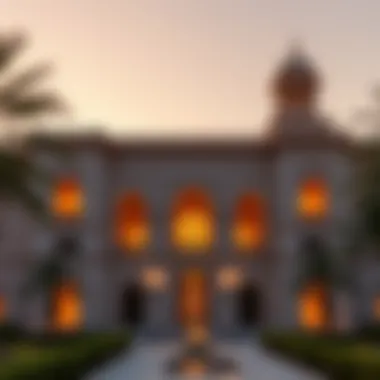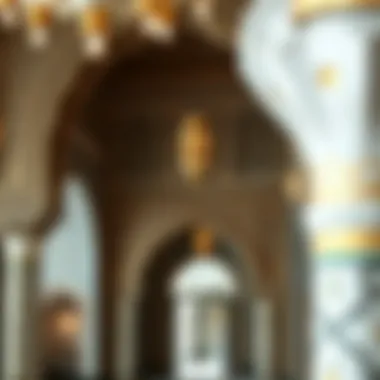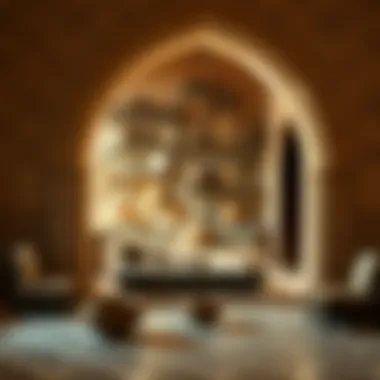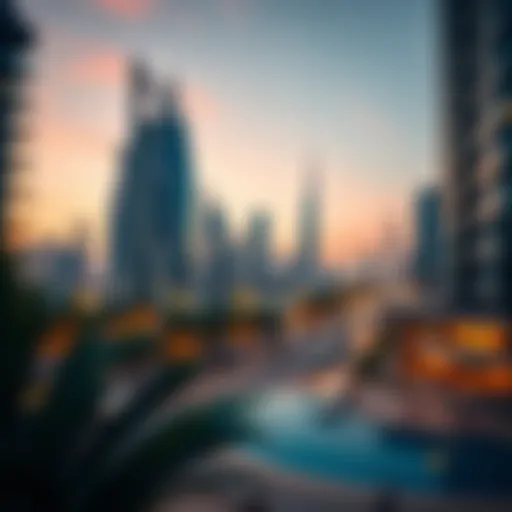Exploring Qasr Al Muwaij'i: Heritage and History


Intro
Qasr Al Muwaij'i stands as a testament to the rich tapestry of history and culture found within the United Arab Emirates. Nestled in the heart of Al Ain, this heritage site whispers stories from the past, echoing the lives and traditions of those who once inhabited its walls. More than just a structure of stone and mortar, it serves as a living museum, reflecting the artistic and architectural sensibilities of its time.
Visitors and researchers alike are drawn to experience the site’s architectural beauty and comprehensive narratives. The Qasr was originally built as a royal residence and a strategic fort, yet its role has evolved over the years, encapsulating a significant chapter in the Emirati story. By examining its features, historical significance, and contemporary relevance, one can grasp not only the stature of the Qasr itself but also its contributions to the broader Emirati heritage.
The architectural elements showcase an intriguing blend of traditional Arabian design and innovative construction techniques. This melding creates a unique aesthetic that speaks volumes about the cultural interchanges that have shaped the region. As we traverse through this exploration, we will unearth the layers of history tied to Qasr Al Muwaij'i, and reflect upon its enduring impact on the cultural landscape of the UAE.
In the sections to follow, we will delve deep into the architectural features that characterize this landmark, its historical context, and the pivotal role it plays in modern cultural identity. By the time we conclude this examination, readers will have gained a well-rounded understanding of not just the monument itself but its echoing relevance in today's world.
Prolusion to Qasr Al Muwaij'i
Exploring Qasr Al Muwaij'i is like peeling back the layers of time in the United Arab Emirates. This landmark is not just a building; it embodies the cultural and historical essence of Emirati life. The importance of this article is rooted in its aim to illuminate the interplay between the past and present that this site represents. By diving into its rich history, architectural brilliance, and significant role within Emirati heritage, readers will find themselves on a journey that connects them to the very soul of a nation.
Understanding Qasr Al Muwaij'i extends beyond mere appreciation of its physical structure; it compels one to recognize how such sites serve as narratives of identity and continuity. For investors, realtors, homebuyers, developers, and analysts, grappling with the historical context offers valuable insights for navigating the modern yet culturally rich landscape of the UAE.
Location and Accessibility
Qasr Al Muwaij'i is strategically situated in the city of Al Ain, which is often seen as the Garden City due to its abundant greenery and unique mountain landscapes. This site lies a stone's throw away from several key attractions like the Al Ain Oasis and the Al Ain Zoo. Its accessibility is managed through well-maintained roads, making it approachable for both local and international visitors.
If one decides to visit, reaching it by car is the most convenient option. Local transport options such as taxis and ride-hailing services are available, allowing for easy access even for first-time visitors. The location not only facilitates tourism but also serves as an educational hub for those looking to delve deeper into Emirati heritage. Visitors can take advantage of guided tours which provide valuable context, often highlighting stories that resonate within the local community.
Significance in Emirati Heritage
Qasr Al Muwaij'i serves as a cornerstone in understanding Emirati identity. It is not merely an architectural structure; it is a symbol of the region's rich traditions and historical narratives. The palace has witnessed pivotal moments in history and reflects the social dynamics and political landscapes of its time.
One cannot overlook how such historical sites form the bedrock of national pride. They anchor the people to their past while fulfilling the dual role of educating future generations. Furthermore, Qasr Al Muwaij'i stands as a testament to the resilience and ingenuity of the Emirati people, representing a bridge between ancient lifestyles and the modern emirate's rapid development. In essence, this site encapsulates the journey of a nation, and its significance in heritage forms a narrative thread that is woven throughout Emirati culture.
The echoes of history resonating through Qasr Al Muwaij'i remind us that understanding our roots is fundamental in charting our future.
In summary, the importance of Qasr Al Muwaij'i extends into various realms—cultural, educational, and social. By engaging with this site, one engages with the heart of Emirati heritage, which is crucial not just for scholars but also for investors and local stakeholders who are actively shaping the future.
Architectural Features
The architectural features of Qasr Al Muwaij'i not only reflect the aesthetic sensibilities of its era but also serve as a window into the cultural values and traditions of the Emirati people. This section explores the significance of the design, materials, and distinctive style that characterize this historic site. A deeper understanding of these elements is essential for anyone looking to grasp the full impact of Qasr Al Muwaij'i on Emirati identity and heritage.
Design Elements
When one first sets eyes on Qasr Al Muwaij'i, it becomes glaringly obvious that the design is not just functional; it encapsulates a certain grandeur that speaks to its historical significance. The layout of the complex includes an impressive courtyard surrounded by tall, commanding walls. This setup provides not only beauty but also practical consideration for privacy and security in a bygone era.
Additionally, the intricate carvings and ornamental plaster work celebrate Islamic architectural principles while also allowing for natural light to filter through. These design elements bring about a feeling of tranquility, framing the palace not just as a residence but as a sanctuary.
Materials Used
The choice of materials in the construction of Qasr Al Muwaij'i reflects the available resources during its time of build and symbolizes broader cultural narratives. Local materials, such as coral stones, were prominently utilized, emphasizing a connection to the surrounding environment.


Furthermore, traditional building techniques enhanced the durability of the structure. The use of clay and lime plaster also played a significant role in providing insulation against the harsh desert climate. These choices not only highlight resourcefulness but illustrate how Emirati architects responded intelligently to their environment.
Distinctive Style
Qasr Al Muwaij'i stands as a textbook example of traditional Emirati architecture, channeling local aesthetics through its distinctive style. The fortification features smooth, rounded towers that taper elegantly towards the top, promoting both defense and visual allure. The central majlis, or gathering area, epitomizes the communal spirit integral to bedouin life, showcasing how architecture can emphasize social values.
It's worth noting the color palette employed as well; warm tones dominate the exterior, creating a seamless harmony with the desert backdrop. The strategic use of arches and domes not only provides structural strength but also signifies cultural connections that date back centuries. This seamless integration of form and function reveals that Qasr Al Muwaij'i is more than just a building—it is a narrative frozen in time.
"The art of architecture is not just in its form, but in its ability to tell stories of people and places."
In summary, the architectural features of Qasr Al Muwaij'i encapsulate the heart and soul of Emirati heritage. Its design elements, material choices, and distinctive style culminate in a rich tapestry that showcases not only the craftsmanship of its makers but also the environment and cultural identity of its people.
Historical Context
Understanding the historical context of Qasr Al Muwaij'i provides a window into the past that informs its present significance. These layers of history help to showcase why this site is an invaluable facet of Emirati heritage. By delving into its origins, key events, and the critical role it played during various periods, we can grasp the site’s continuing legacy and relevance in contemporary society.
Origins and Construction
Qasr Al Muwaij'i was constructed in the early 20th century, around the time when the UAE was undergoing a pivotal transformation. Originally built in 1910, this fortress was commissioned by Sheikh Khalifa bin Zayed Al Nahyan, shining a light on the architectural styles prevalent in that period. The structure served not only as a residence but also as a military stronghold. Using locally sourced materials, including limestone and palm fronds, the construction echoed traditional practices while also serving practical purposes.
This region was fiercely contested, and this palace, with its robust walls, signified strength and resilience. The artisans of that era, skilled in techniques passed down through generations, poured their knowledge into crafting this durable edifice. The design elements integrated both aesthetic considerations and defensive functions, serving as a crucial point of shelter and governance.
Key Historical Events
Throughout its existence, Qasr Al Muwaij'i has witnessed key events that shaped not only the local but also regional dynamics. In the 1950s, it became a royal residence for the ruling family. This era marked a time of social and economic reform in the UAE, leading to modernization and development.
One notable event was the visit of Sheikh Zayed bin Sultan Al Nahyan in 1966. His vision for the UAE's advancement laid the groundwork for what the country is today. Events held at the Qasr during this period were instrumental in fostering connections between local rulers, which often influenced resource-sharing and collaborative governance efforts.
Role During Critical Periods
Qasr Al Muwaij'i served as a linchpin during several pivotal moments in Emirati history. Its walls have sheltered discussions that resulted in groundbreaking decisions regarding the formation of the United Arab Emirates in 1971. The political and social landscapes of those times were often complicated, and strongholds like Qasr Al Muwaij'i played a vital role in facilitating negotiations.
During the subsequent years, it adapted to various roles – from a military base to a cultural showcase. The shifting needs of the community influenced its use, and its significance as a center for dialogue and exchange cannot be understated. The Qasr now stands not only as a historical site but as a beacon for ongoing dialogues about heritage, identity, and future aspirations.
"The importance of Qasr Al Muwaij'i extends beyond its physical structure, transcending time to embody the spirit of Emirati resilience and community collaboration."
By exploring this historical context, it becomes clear that Qasr Al Muwaij'i is more than just a physical structure; it is a testament to the narrative of the Emirati people and their journey through time. The palace's continuing tale invites visitors to reflect deeply on its past while considering its future in a rapidly evolving UAE.
Cultural Importance
Qasr Al Muwaij'i serves as an emblematic representation of Emirati culture and identity. Its historical significance intertwines with the collective memory of the region, acting as a cultural touchstone that resonates with the Emirati people. Beyond being a mere building, it encompasses a rich tapestry of stories, traditions, and values that define what it means to be Emirati today. The palace fosters a sense of belonging and continuity, reflecting the historical struggles and triumphs of the community. Its cultural essence is a beacon of pride for many, encapsulating the soul of the nation through the ages, solidifying its role as a symbol of identity.
Symbol of Identity
The identity aspect of Qasr Al Muwaij'i emerges not just from its physical presence but from its longstanding association with the ruling families and their governance. This palace has been a witness to the unfolding of significant historical events. In a society where heritage is cherished, the palace embodies the values of family, honor, and tradition. Visitors often find themselves enchanted, gazing upon its beauty while pondering its past. This feeling of connection is vital for Emiratis, who see the palace as more than stone and mortar—it's woven into the fabric of their identity.


"A people’s identity is often reflected in their history, and Qasr Al Muwaij'i stands as a testament to the enduring spirit of the Emirati narrative."
Recognizing its potency as a cultural symbol, many local initiatives promote its preservation. Schools often incorporate visits to Qasr Al Muwaij'i into their curriculums, ensuring that the younger generation understands its significance. This practice reinforces the idea that heritage is a living continuum, encouraging pride and stewardship among the youth. For investors and developers, this cultural resonance can translate into opportunities that intersect with local interests, fostering initiatives that support the community’s identity.
Conservation Efforts
Efforts to conserve Qasr Al Muwaij'i are critical in maintaining its status as a cultural landmark. The delicate balance between modernization and preservation is at the forefront of conservation strategies. Local authorities prioritize restoration methods that are sensitive to the historical authenticity of the site. Rather than imposing modern alterations, specialists focus on using traditional materials and techniques that reflect the original craftsmanship.
These conservation efforts yield several benefits:
- Cultural Heritage Preservation: Safeguarding the past ensures future generations can experience their history firsthand, allowing them to form connections with their ancestry.
- Tourism Enhancement: A well-preserved site attracts tourists, generating revenue and fostering economic development within the region.
- Community Engagement: Involving local stakeholders in restoration efforts creates a collective sense of ownership, encouraging active participation in cultural preservation.
A noteworthy initiative is the collaboration with UNESCO, which has provided guidelines for sustainable tourism practices that respect the site's historical context. This approach not only benefits members of the community but also positions Qasr Al Muwaij'i as a case study for similar projects across the UAE and beyond.
In light of its cultural importance, the site continues to be a focal point for discussions surrounding Emirati heritage and identity, drawing attention from scholars, policymakers, and general public alike.
Archaeological Discoveries
Archaeological discoveries at Qasr Al Muwaij'i serve as crucial pieces in the larger puzzle of Emirati heritage. They are not just random finds; these artifacts provide insight into the past, illuminating aspects of daily life, culture, and the region's sociopolitical dynamics. Through various excavation initiatives, experts have pieced together narratives that go beyond mere historical records. This underscores the importance of continuing archaeological research to fully grasp the depth of Emirati heritage.
Excavation Findings
Explorations at Qasr Al Muwaij'i have unearthed a variety of artifacts that testify to its historical significance. Among the notable findings are pottery fragments, tools, and remnants of old structures that hint at the site's former grandeur. The presence of ceramics from as early as the Islamic period reveals the trade connections that existed and indicates a thriving community.
Additionally, the discovery of decorative elements suggests that artistry was not just an afterthought but a profound aspect of daily life. The layering of these materials over time paints a picture of the evolution of architecture and design in this region. The newly excavated areas hint at potential further discoveries, making future archaeological endeavors a landscape rich with possibilities.
Impact on Historical Understanding
The findings from Qasr Al Muwaij'i significantly impact our understanding of the UAE's historical narrative. They challenge previous assumptions about the timeline of development in the region and establish Qasr Al Muwaij'i as a pivotal site for certain historical events.
- Reassessing Timelines: With each artifact, historians reassess established timelines and consider new theories about movement patterns in trade and migration.
- Community Life: The everyday items found demonstrate the lifestyle of those who lived in or visited the fort, revealing preferences in food, fashion, and technology, offering depth beyond the dates and names often highlighted in history books.
- Cultural Continuity: Discoveries promote the idea of cultural continuity from ancient times to the present, indicating that traditions and practices have been passed down through generations.
In summary, the archaeological discoveries at Qasr Al Muwaij'i not only enrich our understanding of the past but also invite further exploration and study. They are, in many ways, gateways to the ambitions, struggles, and triumphs of people who lived in this remarkable region. The findings aid in articulating a more nuanced narrative of the UAE, one that weaves together the threads of human experience, community, and resilience.
"Every stone turned over at Qasr Al Muwaij'i tells a story waiting to be heard."
The pursuit of knowledge through these discoveries is a journey that continuously reshapes our comprehension of Emirati history and identity.
Tourism and Visitor Information
The significance of Qasr Al Muwaij'i transcends its historical context and architectural charm; it has become a focal point for tourism in the United Arab Emirates. Visitors are drawn to this site not just for its aesthetic qualities but also for the rich tapestry of culture woven through its walls. Understanding tourism and visitor information about Qasr Al Muwaij'i is essential, as it reflects not only the site's allure but also its role as a conduit for cultural exchange and education.
Visitor Experience
At Qasr Al Muwaij'i, the visitor experience is meticulously curated to engage and enlighten. As you step through its monumental doors, you’re greeted by an atmosphere that echoes with the whispers of history. Guided tours are available, offering insights into the architectural designs and the cultural narratives that have shaped this space over centuries. The guides, often local experts, bring a wealth of knowledge that makes the exploration feel personal and intimate.


- Interactive Displays: Various exhibits present artifacts and multimedia displays that add depth to the experience. Visitors can touch replicas of historical items, enhancing the tactile engagement with the past.
- Photography Opportunities: With its stunning backdrop, Qasr Al Muwaij'i is a favorite among photographers. Visitors often leave with breathtaking images that capture the essence of Emirati history.
- Cafes and Shops: The site thoughtfully incorporates cafes and gift shops, allowing guests to purchase local crafts or enjoy a cup of Arabic coffee while soaking in the ambiance.
To further enrich their visit, travelers are encouraged to explore the surrounding landscape. The site is often bustling with families and tourists, which adds a festive spirit. Overall, the visitor experience is designed to be immersive, bearing witness to the importance of place in shaping cultural identity.
Local Events and Activities
Qasr Al Muwaij'i is not just a static historical monument; it's a vibrant hub of local events and activities that reflect the dynamic culture of the UAE. Seasonal festivals and traditional celebrations frequently occur here, drawing both local inhabitants and international tourists. These events serve to foster community spirit, strengthen cultural ties, and promote understanding of Emirati customs.
Some notable happenings include:
- Cultural Festivals: Events such as the
Future Prospects
The future of Qasr Al Muwaij'i stands at a crossroads, where the richness of its past can usher in new chapters that highlight its value in the ever-evolving Emirati cultural narrative. Focusing on the aspects of preservation initiatives and its integration into modern culture, the aim is to not just safeguard this historical site but also to ensure it resonates with future generations. Ultimately, these efforts serve multiple stakeholders, including investors, realtors, homebuyers, developers, and analysts, providing insights into the benefits of such preservation efforts.
Preservation Initiatives
Preservation initiatives at Qasr Al Muwaij'i are not merely about maintaining bricks and mortar; they embody a deeper commitment to protect a legacy. Various organizations, including local cultural authorities and international heritage bodies, have engaged in comprehensive strategies to ensure the castle remains a beacon of Emirati heritage.
- Documentation and Research: Detailed studies of the site’s architecture and historical context are vital. Scholars and archaeologists meticulously document every feature, creating an invaluable resource for future research.
- Restoration Projects: Careful restoration of different sections is carried out to preserve the original construction techniques and materials. This work requires skilled artisans familiar with traditional methods, keeping alive the craftsmanship that built the palace.
- Community Involvement: Local volunteers and community groups often participate in preservation efforts, fostering a sense of ownership and pride among residents.
These initiatives not only protect the physical structure but also promote ongoing education about the history and significance of Qasr Al Muwaij'i. As the Emirati population grows and urban development intensifies, these preservation efforts become critical for sustaining a tangible connection to the past.
Integration into Modern Culture
Envisioning a future for Qasr Al Muwaij'i involves its successful integration into contemporary cultural landscapes. As times change, the challenge lies in making the castle relevant for a modern audience while respecting its historical importance.
- Cultural Programming: Hosting art exhibitions, musical performances, and educational workshops within the grounds can bridge the gap between past and present. Engaging the youth through innovation—such as multimedia displays—can spark interest in the site’s history.
- Tourism Development: By enhancing visitor experiences through guided tours and interactive sessions, Qasr Al Muwaij'i can become a focal point for cultural tourism, drawing in both local and international visitors. This can boost local economies while heightening awareness of Emirati heritage.
- Collaborative Projects: Partnerships with universities and cultural institutions could breathe new life into the site. These could include research projects, cultural festivals, and art installations that reinterpret historical themes for today’s audience.
In all, integrating Qasr Al Muwaij'i into modern culture ensures it remains a vital part of the community’s identity, thriving alongside the UAE’s rapid development. Such a balance between tradition and innovation lays a solid foundation for the future of this historical landmark.
"Preserving the past is not just about bricks and mortar, it's about safeguarding a world rich with stories and lessons for the generations to come."
The road ahead for Qasr Al Muwaij'i may be laden with challenges, yet the potential for synergy between its past and an exciting modern future offers great promise.
Culmination
When considering the historical and cultural significance of Qasr Al Muwaij'i, it becomes clear that this site is not merely an architectural feat, but a testament to the enduring legacy of Emirati heritage.
Recapping Historical Value
Qasr Al Muwaij'i holds a prominent place in the tapestry of the UAE's history. Originally built in the late 20th century, it served as a residence for local leaders, highlighting the architectural styles and living conditions during that time. Its walls tell stories of important khaliji events, including political discussions that helped shape the modern state of the Emirates.
Moreover, the fort's restoration in recent years underscores an effort to preserve its authenticity and significance. The surrounding landscape and original materials reflect traditional Emirati building practices which, while perhaps overshadowed by modern constructions, carry profound historical meaning. To summarize, this castle isn't just old stones but a chronicle—an unfiltered glimpse into the lives of those who shaped the region.
Invitation to Explore
Visitors to Qasr Al Muwaij'i are invited to walk the same paths where ancestors once tread. For those interested in understanding the deep roots of Emirati culture, a trip to this site can be deeply enlightening. Guided tours provide detailed insights into the fort's architecture and its broader role within the Emirati identity. Additionally, cultural events held periodically bring the history to life, fusing the past with the present.
You can visit Emirates Heritage Club for more information on upcoming events and detailed visitor guides that enhance this unique touristic experience.
In closing, exploring Qasr Al Muwaij'i offers more than just a casual visit; it serves as a portal to understanding the Emirati spirit and its intricate history, making it a valuable experience for scholars, tourists, and anyone with an appreciation for rich cultural narratives.















